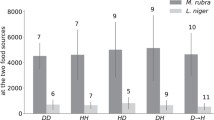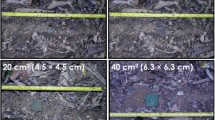Abstract
In this paper we investigate the flexibility of foraging behavior in the leaf-cutting ant Atta colombica, both at the individual and collective levels, following a change in the physical properties of their environment. We studied in laboratory conditions the changes occurring in foraging behavior when a height constraint was placed 1 cm above part of the trail linking the nest to the foraging area. We found that the size and shape of the fragments of foraging material brought back to the nest were significantly modified when the constraint was placed on the trail: independent of their size, forager ants cut smaller and rounder fragments in the presence of a height constraint than in its absence. This size adjustment does not require any direct sensory feedback because it occurred when the ants cut fragments in the foraging area; no further cutting was done when they encountered the constraint. This points to the existence of a template that ants store and use as a reference to adjust their reach while cutting. Remarkably, despite the decrease in the foraging material brought to the nest per capita the colony was still able to improve its foraging performance by doubling the number of transporters. This study illustrates the flexibility of foraging behavior exhibited by an ant colony. It provides a rare example of insects finding an intelligent solution to a problem occurring in a foraging context, at both the individual and collective levels.







Similar content being viewed by others
References
Aiken LS, West SG (1991) Multiple regression: testing and interpreting interactions. Sage Publications, Newbury Park
Anderson C, Jadin JLV (2001) The adaptive benefit of leaf transfer in Atta colombica. Insect Soc 48:404–405
Beckers R, Goss S, Deneubourg J-L (1993) Modulation of trail laying in the ant Lasius niger (Hymenoptera: Formicidae) and its role in the collective selection of a food source. J Insect Behav 6:751–759
Bonabeau E, Theraulaz G, Deneubourg J-L, Aron S, Camazine S (1997) Self-organization in social insects. Trends Ecol Evol 12:188–193
Bonabeau E, Dorigo M, Theraulaz G (1999) Swarm intelligence—from natural to artificial systems. Oxford University Press, Oxford
Burd M (1995) Variable load size-ant size matching in leaf-cutting ants, Atta colombica (Hymenoptera: Formicidae). J Insect Behav 8:715–722
Burd M (1996) Foraging performance by Atta colombica, a leaf-cutting ant. Am Nat 148:597–612
Camazine S, Deneubourg J-L, Franks N, Sneyd J, Theraulaz G, Bonabeau E (2001) Self-organization in biological systems. Princeton University Press, Princeton
Cherrett JM (1972) Some factors involved in the selection of vegetable substrate by Atta cephalotes (L.) (Hymenoptera: Formicidae) in tropical rain forest. J Anim Ecol 41:647–660
de Biseau J-C, Deneubourg J-L, Pasteels J-M (1991) Collective flexibility during mass recruitment in the ant Myrmica sabuleti (Hymenoptera: Formicidae). Psyche 98:323–336
Detrain C, Deneubourg J-L, Pasteels J-M (1999) Decision-making in foraging by social insects. In: Detrain C, Deneubourg J-L, Pasteels J-M (eds) Information processing in social insects. Birkhäuser Verlag, Basel, pp 331–354
Detrain C, Deneubourg J-L (2006) Self-organized structures in a superorganism: do ants “behave” like molecules? Phys Life Rev 3:162–187
Detrain C, Natan C, Deneubourg J-L (2001) The influence of the physical environment on the self-organised foraging patterns of ants. Naturwissenschaften 88:171–174
Dussutour A, Beshers S, Deneubourg J-L, Fourcassié V (2007) Crowding increases foraging efficiency in the leaf-cutting ant Atta colombica. Insectes Soc 54:158–165
Engqvist L (2005) The mistreatment of covariate interaction terms in linear model analyses of behavioural and evolutionary ecology studies. Anim Behav 70:967–971
Feener DH, Lighton JRB, Bartholomew GA (1988) Curvilinear allometry, energetics and foraging ecology: a comparison of leaf-cutting ants and army ants. Funct Ecol 2:509–520
Fewell JH, Harrison JF (1991) Flexible seed selection by individual harvester ants, Pogonomyrmex occidentalis. Behav Ecol Sociobiol 28:377–384
Fowler HG, Robinson SW (1979) Foraging by Atta sexdens (Formicidae: Attini): seasonal patterns, caste and efficiency. Ecol Entomol 4:239–247
Garnier S, Gautrais J, Theraulaz G (2007) The biological principles of swarm intelligence. Swarm Intell 1:3–31
Giurfa M (2003) Cognitive neuroethology: dissecting non-elemental learning in honeybee brain. Curr Opn Neurobiol 13:726–735
Giurfa M (2007) Behavioral and neural analysis of associative learning in the honeybee: a taste from the magic well. J comp Physiol A 193:801–824
Gordon DM (1996) The organization of work in social insect colonies. Nature 380:121–124
Hart AG, Ratnieks FLW (2001) Leaf caching in the leafcutting ant Atta colombica: organizational shift, task partitioning and making the best of a bad job. Anim Behav 62:227–234
Hölldobler B, Wilson EO (1990) The ants. Harvard University Press, Cambridge
Howard JJ (2001) Costs of trail construction and maintenance in the leaf-cutting ant Atta colombica. Behav Ecol Sociobiol 49:348–356
Howard JJ, Henneman ML, Cronin G, Fox JA, Hormiga G (1996) Conditioning of scouts and recruits during foraging by a leaf-cutting ant, Atta colombica. Anim Behav 52:299–306
Hubbell SP, Johnson LK, Stanislav E, Wilson B, Fowler H (1980) Foraging by bucket-brigade in leaf-cutter ants. Biotropica 12:210–213
Kim J (2007) Disc size regulation in the brood cell building behavior of leaf-cutter bee, Megachile tsurugensis. Naturwissenschaften 94:981–990
Johnson RA (1991) Learning, memory, and foraging efficiency in two species of desert seed-harvester ants. Ecology 72:1408–1419
Le Breton J, Fourcassié V (2004) Information transfer during recruitment in the ant Lasius niger L. (Hymenoptera, Formicidae). Behav Ecol Sociobiol 55:242–250
Lopes JFS, Orti LCF, Camargo RS (2004) The influence of the scout upon the decision-making process of recruited workers in three Acromyrmex species (Formicidae: Attini). Behav Proc 67:471–476
Lutz FE (1929) Observations on leaf-cutting ants. Am Mus Novit 388:1–21
Mailleux AC, Detrain C, Deneubourg J-L (2006) Starvation drives a threshold triggering communication. J Exp Biol 209:4224–4229
Menzel R, Giurfa M (2006) Dimensions of cognition in an insect, the honeybee. Behav Cogn Neurosc Rev 5:24–40
Nichols-Orians CM, Schultz JC (1989) Leaf thoughness affects leaf harvesting by the leaf cutter ant, Atta caphalotes (L.) (Hymenoptera: Formicidae). Biotropica 21:80–83
Pasteels J-M, Deneubourg J-L, Goss S (1987) From individual to collective behavior in social insects. Les Treilles Workshop, Basel
Prado L (1973) Le comportement de decoupage des feuilles chez Atta sexdens. Insect Soc 20:133–144
Rissing SW (1981) Foraging specializations of individual seed-harvester ants. Behav Ecol Sociobiol 9:149–152
Roces F (1990) Leaf-cutting ants cut fragment sizes in relation to the distance from the nest. Anim Behav 40:1181–1183
Roces F, Núñez JA (1993) Information about food quality influences load-size selection in recruited leaf-cutting ants. Anim Behav 45:135–143
Roces F, Hölldobler B (1994) Leaf density and a trade-off between load-size selection and reruitment behavior in the ant Atta cephalotes. Oecologia 97:1–8
Rudolph SG, Loudon C (1986) Load size selection by foraging leaf-cutter ants (Atta cephalotes). Ecol Entomol 11:401–410
Seeley TD (1995) The wisdom of the hive: the social physiology of honey bee. Harvard University Press, Cambridge
Seeley T, Camazine S, Sneyd J (1991) Collective decision-making in honey bees: how colonies choose among nectar sources. Behav Ecol Sociobiol 28:277–290
Shutler D, Mullie A (1991) Size-related foraging behaviour of the leaf-cutting ant Atta colombica. Can J Zool 69:1530–1533
Stradling DJ (1978) The influence of size on foraging in the ant, Atta cephalotes, and the effect of some plant defence mechanisms. J Anim Ecol 47:173–188
Van Breda JM, Stradling DJ (1994) Mechanisms affecting load size determination in Atta cephalotes L. (Hymenoptera, Formicidae). Insect Soc 41:423–434
Weber NA (1972) Gardening ants the attines. Memoirs of the American Philosophical Society, Philadelphia
Wetterer JK (1990) Load-size determination in the leaf-cutting ant, Atta cephalotes. Behav Ecol 1:95–101
Wetterer JK (1991) Source distance has no effect on load size in the leaf-cutting ant, Atta cephalotes. Psyche 98:355–359
Wilson EO (1980) Caste and division of labor in leaf-cutter ants (Hymenoptera: Formicidae: Atta). I. The overall pattern in Atta sexdens. Behav Ecol Sociobiol 7:143–156
Wirth R, Herz H, Ryel RJ, Beyschlag W, Hölldobler B (2003) The herbivory of leaf-cutting ants. A case study on Atta colombica in the Tropical Rainforest of Panama. Ecological studies. Springer, Heidelberg
Acknowledgments
We thank M. Gauthier and M. Giurfa for helpful discussions. A. D. was supported by a mobility fellowship (bourse de co-tutelle Belgique-France) from the French Ministry of Scientific Research and a fellowship (ATUPS) from Paul Sabatier University (Toulouse, France). J. L. D. is a research associate from the Belgian National Fund for Scientific Research.
Author information
Authors and Affiliations
Corresponding author
Rights and permissions
About this article
Cite this article
Dussutour, A., Deneubourg, JL., Beshers, S. et al. Individual and collective problem-solving in a foraging context in the leaf-cutting ant Atta colombica . Anim Cogn 12, 21–30 (2009). https://doi.org/10.1007/s10071-008-0165-0
Received:
Revised:
Accepted:
Published:
Issue Date:
DOI: https://doi.org/10.1007/s10071-008-0165-0




